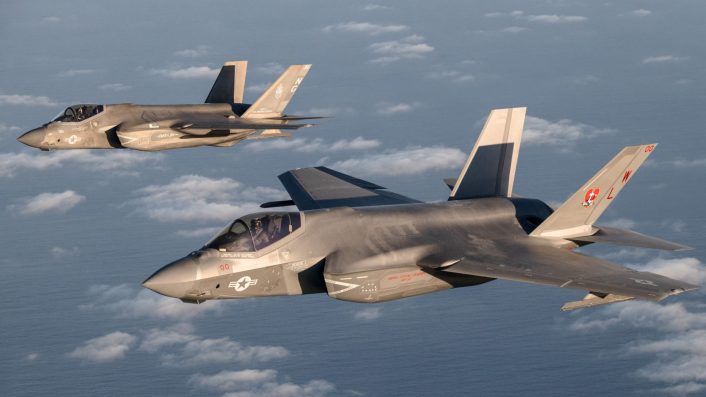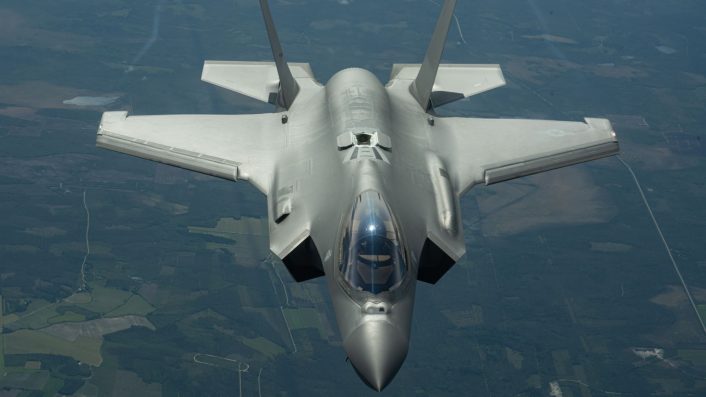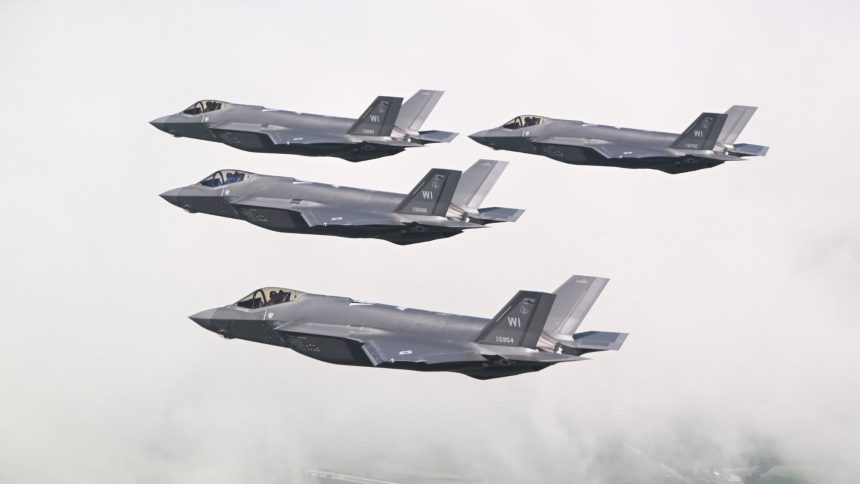A total of 72 aircraft were parked at Lockheed Martin’s facilities after the Technology Refresh 3 experienced severe glitches, following which the Pentagon halted deliveries in July 2023.
Lockheed Martin has delivered the backlogged F-35 Lightning II fighters that were parked at its facilities owing to problems with the Technology Refresh 3 (TR-3) software code, reported Bloomberg. The Pentagon stopped accepting new deliveries for a year in July 2023 owing to the snagged software, withholding payments to Lockheed Martin.
The military and the company later agreed for a “truncated” version of the program as a stopgap arrangement. This allowed the deliveries to resume in 2024, and on May 1, 2025, the final backlogged F-35 was delivered.
The number of jets that piled up at Lockheed’s Fort Worth facilities in Texas were also revealed to be 72, Defense One said. A Jan. 2024 Breaking Defense report quoted Lockheed Martin’s chief financial officer Jay Malave, who said a total of 100-120 aircraft might be undelivered by the end of 2024 owing to the backlog.
The company has been consistently delivering aircraft over the last year. Breaking Defense quoted Lockheed Martin’s head of aeronautics division Greg Ulmer and vice president for business development J.R. MacDonald who said, as of early June, the company has delivered 200 F-35s in the TR-3 configuration, and forecasts a delivery of 170-190 aircraft this year.
We recently began to deliver TR-3 configured F-35s. The upgraded aircraft in this initial phase are equipped with combat training capabilities—a key step toward full operational capabilities. pic.twitter.com/VWMvWFV761
— F-35 Lightning II (@thef35) July 19, 2024
Meanwhile, the fully operational TR-3 is now also ready, MacDonald told journalists in June on the sidelines of the Paris Air Show, saying the company believes “it has reached that point” and is pending only a “final closure from the U.S. government.” The F-35 JPO (Joint Program Office) has, in fact, to give formal approval to integrate it in the production line.
TR-3 and Block 4
The Technology Refresh 3 (TR-3) program would serve as the “backbone” for the upcoming Block 4 upgrades involving new weapons and processors, as well as sensor fusion, data processing and electronic warfare. The program experienced severe glitches, following which the Pentagon stopped accepting deliveries in July 2023, leading to aircraft piling up at Lockheed’s Texas facilities.
The Block 4 includes hardware upgrades to 75 major systems, with enhancements to the electronic warfare suite, radar, EOTS (Electro-Optical Tracking System), better cockpit displays, navigation and communication systems and a next-generation Distributed Aperture System (DAS). A recently confirmed upgrade that will come with Block 4 is the new APG-85 AESA radar, which will replace the current APG-81.

Unclassified slides from Lockheed Martin also show Auto Ground Collision Avoidance System integration, a new Open System Architecture, Multi-Domain Operations and Missile Defense capabilities, Manned-Unmanned Teaming and extended range with the use of external fuel tanks.
The troubles
The TR-3 experienced severe glitches, following which the Pentagon stopped accepting deliveries in July 2023, leading to aircraft piling up at Lockheed’s Texas facilities. As per a May 2024 GAO (Government Accountability Office) report, the TR-3 software could not support the F-35’s radar and electronic warfare systems.
The report added some test pilots had to reboot their radar and EW systems mid-flight in an attempt to solve issues. “Program officials stated that early versions of radar and in-flight systems software can commonly experience rebooting issues,” the GAO said. “However, even after being nearly a year delayed, TR-3 software continues to be unstable, according to test officials.”
US Marine Corps F-35B Lightning II fighters take off from UK aircraft carrier HMS Prince of Wales ahead of Exercise Talisman Sabre 🇬🇧🇺🇸
We train together, we stand together, we fight together.@thef35 pic.twitter.com/lTFyNzbFml
— UK Defence Staff in US (@UKdefUS) July 15, 2025
The Integrated Core Processor, developed by L3Harris, is central to this upgrade. It exponentially enhances data processing and sensor fusion speeds that aid optimum decision-making and pilot assistance in complex and dangerous missions. The TR-3 upgrade also includes a newer, larger display.
While problems were being worked on, Lockheed Martin continued to build planes equipped with a “truncated” TR-3, as per an arrangement with the DoD and the F-35 JPO (Joint Program Office), to offer some of the planned capabilities. Freshly built airframes with the interim TR-3 version began deliveries from July 2024 onwards when the embargo was lifted, with the first two TR-3 ready F-35As delivered to Danny Airfield, Alabama, and Nellis AFB, Nevada.
The fully matured and the complete software package would be retrofitted on the delivered F-35 airframes once work on it is done. As we reported here at The Aviationist in May 2024, the retrofit requires 14 days of downtime and would be performed during scheduled maintenance.
Eielson F-35A Lightning II’s arrived in Guam for Resolute Force Pacific 25!
REFORPAC is employing more than 400 Joint and coalition aircraft and more than 12,000 members at more than 50 locations across 3,000 miles.https://t.co/qGsroPbXxh#REFORPAC25 #DLE2025 #ReadyAF pic.twitter.com/Jhax3KHucZ
— Eielson Air Force Base (@EielsonAirForce) July 14, 2025
F-35 future
Bloomberg reported in September 2023 that the Pentagon was also withholding $7 million per aircraft, translating into Lockheed Martin potentially losing up to $800 million in dues and sale revenues. Reuters put the figure at $5 million a piece, adding that the number was reduced to about $1.2 million in January 2025, after Lockheed made progress on the TR-3 issues.
The company’s efforts to speed up F-35 deliveries also come amid reduced F-35 acquisition in the FY2026 budget, as the aircraft contributes about 30% of its revenue. Defense News reported that the Air Force would procure only 24 F-35As in 2026 for roughly $4 billion, less than the 44 F-35s, costing $4.8 billion, the Air Force is on track to buy this year, and the 51 jets, worth $5.5 billion, the service bought in 2024.

Former senior Air Force officials recently criticized the move in an open letter, pointing to how such reductions will undermine the United States’ deterrence before its adversaries and hurt military readiness. The E-7A Wedgetail AEW&C aircraft is another platform which would not receive additional orders, while the Air Force plans to replace it with the E-2 Hawkeye used by the U.S. Navy.









